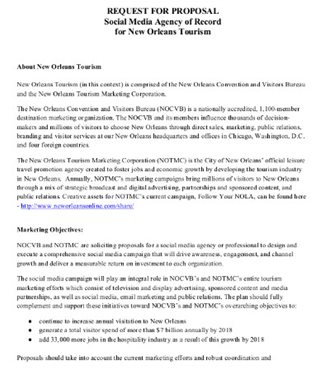 ≡
≡
Executive Summary. A must have In Every Proposal
Dec 29, 2023 by Sean Luce During my last market visit to Kelowna, British Columbia, I worked with the staff on proposal writing. As I scoped out the proposals about to leave the station, I noticed that something was missing. Sales reps often skip this item, which happens to be one of the most important elements to be included. One particular proposal was perfect except that it was missing the Executive Summary/cover letter page.
During my last market visit to Kelowna, British Columbia, I worked with the staff on proposal writing. As I scoped out the proposals about to leave the station, I noticed that something was missing. Sales reps often skip this item, which happens to be one of the most important elements to be included. One particular proposal was perfect except that it was missing the Executive Summary/cover letter page.
Here are a few reasons that prospects throw out radio proposals, and the executive summary is one of them:
- The proposal doesn't follow a specified format.
- The proposal is full of station features and benefits.
- The template contains another customer's name. (Shameful!)
- The proposal has grammatical errors.
- The executive summary doesn't address customers' needs.
The executive summary should always be right behind the "Header Page" (first page, which has the company's logo). There is a title, such as "Increasing UP traffic at your dealership" or "Moving those 50 extra Lay-Z-Boy recliners." The executive summary's length is predicated on the length of your proposal. Anything that's less than 50 pages (and I hope most of your proposals are) should have a two- to a three-paragraph summary on one page.
The executive summary serves as a review of your needs-analysis call that determined the problem or opportunity for which you are presenting solutions. The executive summary is critical, in that it provides a review of what took place in your first meeting. If you don't take the prospect back to what you discussed when you did the "needs" call (we require our reps to be back within 72 hours to make the closing presentation), many things could have been forgotten or lost in the intervening days or weeks that it takes the rep to return with a proposal.
Here's a startling statistic: In an average week, the main decision-maker is called on or solicited by 28.6 salespeople. Every passing day, other reps are in the prospect's mind, selling some kind of product or service. You just can't afford to let much time go by. Remember that buying is usually based on emotion and then backed by logic.
The executive summary should include a letter that is pragmatic and specific - it should not ramble on. Customer-focused, it allows you the opportunity to immediately engage the prospect with what you will cover in your proposal.
Note: If any objections are given at this point, always defer to the end of the presentation, because his/her objection might be covered in your proposal. If you try to overcome the objection at this stage, the customer is now in control of your proposal, and it can throw off the continuity of your presentation.
Here's an example of a good summary letter:
Dear John,
Since our last meeting on Monday, August 6, 2018, I have shared some thoughts with our production department to develop a creative campaign to bring an additional 600 new prospects into your store. As we discussed, this is the number of customers that your furniture store needs over the next 12 months so that your salespeople can sell a minimum of 120 recliners, based on your 20-percent closing ratio.
The schedule I put together is based on achieving a frequency of 3 during the weeks we are on the radio station. This schedule is based on the $40,000 dollars we discussed and based on your average sale of $1,000 per ticket. Calculating your profit margin into our Equation for Success formula, and figuring a 20-percent threshold for your ROI, I think this is very doable, considering that your salespeople are well trained and can close a prospect.
I look forward to providing the continuous ideas needed to generate new prospects for your furniture store. The enclosed proposal contains various testimonials pertaining to the success of other businesses in Kelowna, so I feel confident that our expectations are in line with reality, based on your customer counts of the last two years.
Note: Make sure that you don't read this summary to the prospect. Instead, yellow-highlight the main points that are critical to the success of the proposal, and verbally summarize your points to the prospect.
Related Categories> Publications > Radio Ink




